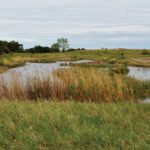
Tag Archives Conservation

ALUS gains steam in western Manitoba
ALUS returned to its roots in the Little Saskatchewan River Conservation District in 2014, and producers are buying in

New law aims to protect wetlands, lakes, rivers
The Manitoba government passes its Sustainable Watersheds Act to co-ordinate programs and policy in water management
The Manitoba government has adopted a carrot-and-stick approach to addressing an issue that has divided neighbours and cost the provincial economy billions due to flooding and reduced water quality. Fines for breaking the rules will rise sharply, but incentives for protecting key wetlands are being developed, and the approval process for low-impact drainage projects will be streamlined.
2,000 Hectares That’s how much wetland Manitoba loses every year to drainage. The new law specifies no net loss of “wetland benefits.” Source: Manitoba government $748 Million Protecting key wetlands would prevent 1,000 tonnes of P and 55,000 tonnes of N from entering lakes and waterways annually. The estimated saving on removal using existing technology:
New era beginning for conservation work, says MCDA chairman
Meetings held to talk over future boundary changes, new programming
Editorial: Go ask ALUS

Manitoba budget contains multimillion-dollar conservation trust
There’s great potential for the trust to help farmers help the environment, says KAP

Report pegs U.S. dairy support levels

Neepawa couple committed to prairie rehabilitation
Paul and Larissa Koshel are the Whitemud Watershed Conservation District’s 2017 Conservation Award winners for their work restoring a small plot of native prairie plus a three-acre wetland

Province tables Sustainable Watersheds Act
Incentives would be offered landowners who protect wetlands and adopt other beneficial land management practices
Wetland restoration in Pembina Valley ‘a rarity,’ said CD officials
About 160 acres have been converted back to wetland after the landowners farming it saw more advantage using the acres to hold water than farming it at a loss

Imperilled grasslands need more attention, speakers say
They are the most endangered ecosystem in the world, but there is still time to create conservation programs to protect them


